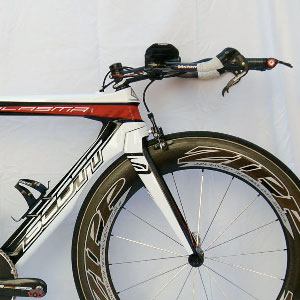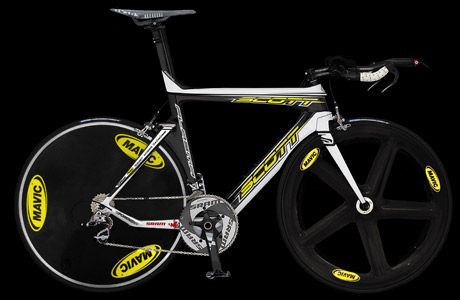Scott Plasma 10 for 2010

Some might know that we host a gaggle of retailers here at the compound roughly once every three weeks, from the beginning of the year through May. Seven workshops in all, about 14 retailers at a time.
What do we teach? Well, first, how to determine a rider's proper position aboard a bike. Any bike. That position is "sticky" and follows the rider from bike to bike. Look at it this way. Do you try to alter your foot based on the running shoe you own? Or do you correctly realize that the shape of your feet, your footfall, your running gait, determines the shoe you'll best wear, not the other way around?
The second part of our bike fit workshops is devoted to the matching of rider to bike. Now that we know what style and geometry of bike you ought to ride theoretically, what bikes in the marketplace match that actually?
The line of Scott Plasmas comes up in the conversation often during our workshops. This, because once you've determined your fit coordinates, certain riders fit best aboard a Plasma. Here's the rub: They almost certainly in this case are bad candidates for bikes on the opposite end of the geometric curve: bikes like Cervelo's P3, QR's CD0.1, and a Kuota Kween K. Really, it's one style or the other.
This, because Scott's line of Plasmas feature a bike that's less "long" horizontally, and, with a head tube that's taller, so, a rider will (all things equal) sit up a bit higher. This, in relation to these other bikes mentioned.
Who might best use a bike geometrically built like this? Two cases immediately come to mind. One involves a relatively fit, trim, experienced triathlete, who's probably going to ride with his or her seat angle at least moderately steep. If this person is short-waisted—that is, short in the torso, long-legged—that person is going to need a bike like this: short in length, taller in height. The height is required because that short torso means that rider's height is in his legs. Those taller legs prop the saddle higher, and that means the head tube has to be higher as well, to keep pace with that tall saddle height.
The other sort of rider for which the Plasma is a nice match is the rider who wants to ride a tri bike, but, doesn't want to ride it steep, or low in front. When I see riders aboard Cervelos or Felts who choose the rear of the two available saddle positions, with short stems pointed skyward, and 4cm or 5cm of spacers under the stem, these are riders who needed narrower, taller bikes, just like the Scott Plasma reviewed here. (This assumes the rider was positioned properly by his fitter.)

Let me tell you why the Plasma II frameset (featured here in the Plasma 10 and the Plasma LTD) is a more versatile bike than the Plasma I (featured in the Plasma 20 and Plasma 30 complete bike models). While the Plasma I frameset offers great value, it is less seat angle adjustable. This Plasma II frameset features a Ritchey seat cap that sits overtop the Plasma II's seat mast. This is much more forward adjustable than the seat cap atop the Plasma I (though I highly doubt the claim that it's adjustable from 73° thru 80°). This Ritchey component is the same seat cap used on the Ridley Dean frameset.
Scott bikes are very popular at the Hawaiian Ironman, placing second to Cervelo in the bike count. This is impressive, if you consider the fact that there is no entry-level iteration of these bikes—the Plasma 30 sells for $2700 and change. But this frameset here, the Plasma II, is the one I like best, because of its geometric versatility.
The Plasma 10, which features the Plasma II frameset, sells for $4900-ish. This is a lot of frame for that price, and, if you look at its details—most impressively the fork/frame seamless intersection—this bike has been the subject of a lot of attention to detail.
The groupkit is Shimano Dura Ace almost throughout, that is, not just F and R derailleurs and dry dog food everywhere else, as is the current custom for tri bikes. Rather, brake calipers, crank and BB are also Dura Ace. The mild fall-down is in the wheels: Shimano WH-RS10 are midrange at best. But I don't much mind this, if this keeps the price of the complete bike down. I'm a believer in owning multiple sets of beater training wheels and the RS10 is eminently qualified. On the flip side, you get a Fizik Arione Tri II spec'd original equipment on this model.

My one beef with this bike is the choice of aerobar spec. Profile Design's T2+ Cobra is a nice bar, and, I have no beef with it. But is it a thematic, geometric, match for this bike? Let me make my case that it is probably not through a look at Luke McKenzie's Plasma II bike (pictured adjacent), closer in build to Scott's Plasma LTD (McKenzie's bike features SRAM Red just like the Plasma LTD). You'll want to read our overview of Luke's bike and our interview with Luke about it. Note the following on Luke's bike: Visiontech bars, no spacers under the downturned stem. Also note Luke's vertical displacement between saddle and aerobars: a not overly deep 10cm. I ride with 15cm of armrest drop, Jordan Rapp rides with 18.5cm. Torbjorn Sindballe rides with 17cm.
This is not to say they give podium spots away for front end lowness, rather, that the Scott is a tall bike, and, if you need a tall bike that's what you need (and an awful lot of people do). But, if you place tall aerobars on a tall bike, then you make a really tall bike. If Mr. McKenzie must use a low-profile aerobar with no spacers and a downturned stem to get to 10cm, imagine how hard it would be for a rider to get lower yet?
Now, it isn't as bad as all that. Luke rides a saddle height of only 72.5cm, compared to my 79cm, Rappstar's 82cm, and Thunderbear's 79.5cm. See the progression? The taller the saddle, the greater the armrest drop. Luke's armrest drop is appropriate for his height or, even, slightly less aggressive than one might expect. Nevertheless, he'd have a hard a hard time getting to his fit coordinates with the aerobar spec'd OE on this model.
Remember that other Scott model that features the Plasma II frame, the Plasma LTD? That bike comes spec'd with Profile Design's CX3. That's a perfect spec for this frame, and, geometrically, would be more or less equivalent to the Visiontech bar Luke McKenzie rides. For a nice bike like this, priced as it is, that bar ought to be spec'd on this Scott Plasma model as well.
With one caveat. Remember when I described the two sorts of riders who'll successfully use this bike? Luke is the high-performance example. But for the other sort of rider, the fellow who won't ride as steep as Luke, maybe who's carrying a third grader just above his belt, and, who'll need that extra elevation in the armrests? For this rider, those Profile Design bars that come OE might just be fine.
Just know that if you're a leggy, high performance, rider, the Plasma 10's OE bars might be best swapped with either the bars that come on the Plasma LTD, or Visiontechs, or HED's Vantage Eight, or some other low-profile aerobar.
With all those caveats established, you might by now have figured out whether this bike is the sort that might work for you. What I tell these dealers that aggregate at the Compound for our fit workshops is this: Scott, or Cannondale, is each a bike line that ought to be paired with Cervelo, Felt, and the other longer, lower-geometry bike lines in your store. Carrying Scott and C'dale alone leaves a hole in your offerings. Likewise, Cervelo and Felt only leaves a hole as well—a hole that Scott elegantly fills, especially so with this particular model.
I want to end by touching on aerodynamics, because, this is a very misunderstood, very poorly conceived, discussion most of the time. Consider all the "superbikes" talked about on reader forums like ours. Consider the Specialized Shiv, the Trek Speed Concept, Scott's own Plasma III (yet to be unveiled in its for-sale iteration). All these bikes have one thing in common: They seek to make the stem disappear, melding the handlebars to the frame/fork in a seamless fashion.
These bike designers are so intent on doing this that they'll in some cases give up all sorts of basic functionality—chiefly adjustability—in order to get an aero advantage. Now, think about this. The posture of the timed race designers of today is to gain aerodynamics by getting rid of exposed stems, steer columns, spacers, and the like.
So, when you show up to the group rides sporting a Felt B2, a Cervelo P4, a Ridley Dean, and you have 3cm or 4cm of steerer showing, with a stem that points to the sky, how aerodynamic, really, is your aero machine? This isn't to cast aspersions on these fine bikes—I ride a P3 myself. But my legs are not long, if anything my torso is slightly long. I ride the bike with no spacers under the stem. My P3 is the right bike for me, and a Felt would fit me nicely as well.
My point: We can haggle about whether the Plasma's "Shelter127" aero technology is as good as Quintana Roo's CD0.1's wind-shunting downtube profile. Fine, let's have that discussion. Meanwhile, I hope we can all stipulate that a CD0.1 with 5cm of spacers under the stem is certainly aerodynamically inferior to the Plasma II with a 1cm spacer exposed. Not only power, not only handling, not only comfort, but superior aerodynamics is largely tied to choosing a bike that properly fits you.
For this reason, a Scott Plasma may well be your most aerodynamic bike. Especially this model, because of the seat angle adjustability the Plasma II frame gives you.






Start the discussion at forum.slowtwitch.com